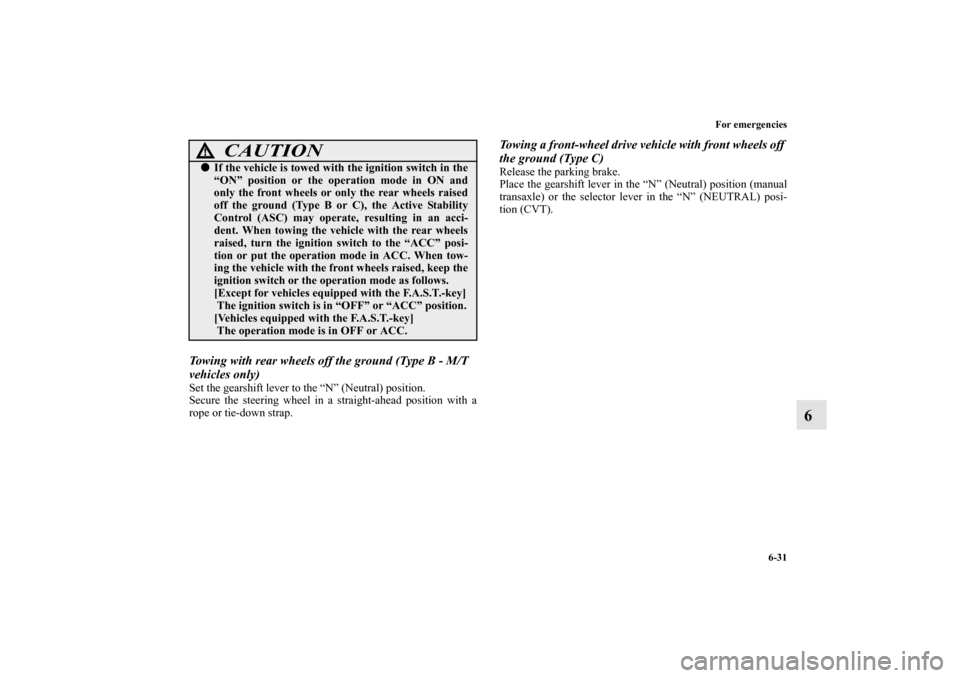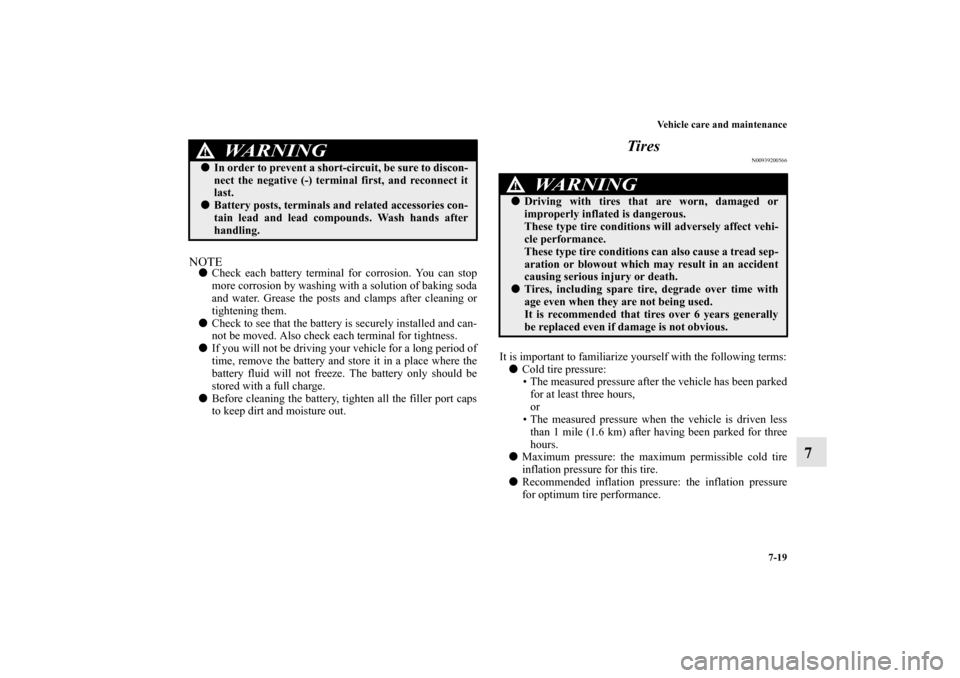Page 352 of 460
6-12 For emergencies
6
7. Take the valve cap (D) off the tire valve (E).
8. Unwind the bottle hose (F) from around the sealant bottle.9. Pull out the compressor’s hose (G) from the bottom of the
compressor and securely attach it to the valve (H) of the
bottle by turning it clockwise until tight.
BK0162600US.book 12 ページ 2013年3月22日 金曜日 午後2時41分
Page 353 of 460
For emergencies
6-13
6
10. Install the bottle onto the compressor.NOTE�When installing the bottle, align the projection (I) on the
bottle with the indentation (J) in the compressor.11. Securely attach the bottle hose (F) to the tire valve (E).
CAUTION
!�If the bottle hose is not attached securely, the tire
sealant will leak out from the tire valve and the tire
may not inflate to the specified pressure.
BK0162600US.book 13 ページ 2013年3月22日 金曜日 午後2時41分
Page 371 of 460

For emergencies
6-31
6
Towing with rear wheels off the ground (Type B - M/T
vehicles only)Set the gearshift lever to the “N” (Neutral) position.
Secure the steering wheel in a straight-ahead position with a
rope or tie-down strap.
Towing a front-wheel drive vehicle with front wheels off
the ground (Type C)Release the parking brake.
Place the gearshift lever in the “N” (Neutral) position (manual
transaxle) or the selector lever in the “N” (NEUTRAL) posi-
tion (CVT).
�If the vehicle is towed with the ignition switch in the
“ON” position or the operation mode in ON and
only the front wheels or only the rear wheels raised
off the ground (Type B or C), the Active Stability
Control (ASC) may operate, resulting in an acci-
dent. When towing the vehicle with the rear wheels
raised, turn the ignition switch to the “ACC” posi-
tion or put the operation mode in ACC. When tow-
ing the vehicle with the front wheels raised, keep the
ignition switch or the operation mode as follows.
[Except for vehicles equipped with the F.A.S.T.-key]
The ignition switch is in “OFF” or “ACC” position.
[Vehicles equipped with the F.A.S.T.-key]
The operation mode is in OFF or ACC.
CAUTION
!
BK0162600US.book 31 ページ 2013年3月22日 金曜日 午後2時41分
Page 380 of 460
7-6 Vehicle care and maintenance
7
Support the engine hood with the hood prop. Insert the hood
prop securely in the opening under the hood marked with an
arrow.
To closeUnlatch the prop from the engine hood and put it back in its
retainer.
Slowly lower the engine hood about 8 inches (20 cm), then let
it drop from its own weight.
CAUTION
!�Always insert the support prop into the hole spe-
cially made for it. Propping the engine hood at any
other place could cause the prop to slip out and lead
to an accident.�The hood prop can fall out if the hood is lifted by a
strong wind.
CAUTION
!�Be careful not to trap your hands or fingers when
closing the engine hood.�Make sure the engine hood is firmly closed before
driving.
If you drive without the engine hood completely
closed, it could open up while driving.
BK0162600US.book 6 ページ 2013年3月22日 金曜日 午後2時41分
Page 391 of 460

Vehicle care and maintenance
7-17
7 Battery
N00939100943
The condition of the battery is very important for quick starting
and to keep the vehicle’s electrical system working properly.
Check the battery regularly.Checking battery electrolyte level
N00901500072
The electrolyte level must be between the limits shown on the
outside of the battery. Fill it with distilled water as needed. The
inside of the battery is divided into several compartments. Take
the cap off of each compartment and fill to the mark.
Do not fill above the top line because a spill during driving
could cause damage.
During cold weather
N00901600060
The battery is weaker in cold temperatures. This has to do with
its chemical and physical properties and is why a very cold bat-
tery, especially one with a low charge, will have a hard time
starting your vehicle.
It is recommended that you have your battery and charging sys-
tem checked by an authorized Mitsubishi Motors dealer or a
repair facility of your choice before the start of cold weather. If
necessary, have it charged. This will provide more reliable
starting, and longer battery life.
WA R N I N G
!�If the battery goes flat, be sure to check the battery
electrolyte level before connecting booster cables.�After checking the battery electrolyte level, make
sure the caps are fitted securely.�If any of the caps has a loose fit, replace the battery.
BK0162600US.book 17 ページ 2013年3月22日 金曜日 午後2時41分
Page 393 of 460

Vehicle care and maintenance
7-19
7
NOTE�Check each battery terminal for corrosion. You can stop
more corrosion by washing with a solution of baking soda
and water. Grease the posts and clamps after cleaning or
tightening them.
�Check to see that the battery is securely installed and can-
not be moved. Also check each terminal for tightness.
�If you will not be driving your vehicle for a long period of
time, remove the battery and store it in a place where the
battery fluid will not freeze. The battery only should be
stored with a full charge.
�Before cleaning the battery, tighten all the filler port caps
to keep dirt and moisture out.
Tires
N00939200566
It is important to familiarize yourself with the following terms:
�Cold tire pressure:
• The measured pressure after the vehicle has been parked
for at least three hours,
or
• The measured pressure when the vehicle is driven less
than 1 mile (1.6 km) after having been parked for three
hours.
�Maximum pressure: the maximum permissible cold tire
inflation pressure for this tire.
�Recommended inflation pressure: the inflation pressure
for optimum tire performance.
�In order to prevent a short-circuit, be sure to discon-
nect the negative (-) terminal first, and reconnect it
last.�Battery posts, terminals and related accessories con-
tain lead and lead compounds. Wash hands after
handling.
WA R N I N G
!
WA R N I N G
!�Driving with tires that are worn, damaged or
improperly inflated is dangerous.
These type tire conditions will adversely affect vehi-
cle performance.
These type tire conditions can also cause a tread sep-
aration or blowout which may result in an accident
causing serious injury or death.�Tires, including spare tire, degrade over time with
age even when they are not being used.
It is recommended that tires over 6 years generally
be replaced even if damage is not obvious.
BK0162600US.book 19 ページ 2013年3月22日 金曜日 午後2時41分
Page 405 of 460

Vehicle care and maintenance
7-31
7 Emission-control system maintenance
N00940800328
Your vehicle is equipped with an emission-control system that
meets all the requirements of the U.S. Environmental Protec-
tion Agency and Environment Canada. The emission-control
system is made of:
�a positive crankcase ventilation system
�an evaporative emission-control system
�an exhaust emission-control system
To be sure the emission-control system works properly, have
your vehicle inspected and maintained by an authorized
Mitsubishi Motors dealer or a repair facility of your choice.
This should be done at the time or mileage specified in the
“WARRANTY AND MAINTENANCE MANUAL”.
These, and all the other “general” maintenance services listed
in this manual, need to be performed to keep your vehicle run-
ning properly and reliably.
You should also have an inspection and service any time you
suspect a malfunction.NOTE�To meet government regulations and promote cleaner air,
your vehicle is equipped with an onboard diagnostic sys-
tem (OBD). The engine electronic control module that
controls OBD functions stores various data (especially
about the exhaust emissions). This data will be erased if
the battery cable is disconnected, which could make a
rapid diagnosis difficult. Do not disconnect the battery
cable when the engine malfunction indicator (“SERVICE
ENGINE SOON” or “Check engine light”) is ON.
Spark plugs
N00940900228
Spark plugs must fire properly for good engine performance
and emission-control.
Do not reuse them by cleaning or regapping. Change them at
the mileage listed in the “WARRANTY AND MAINTE-
NANCE MANUAL”. NOTE�Use the spark plugs listed under “Engine specifications”
on page 9-7 or plugs that are exactly the same. Other
plugs could cause engine damage, performance problems
or radio noise.Fuel hoses
N00941000040
Check the hose surfaces for any heat and mechanical damage,
hard and brittle rubber, cracking, tears, cuts and abrasions. Pay
special attention to the hoses closest to high heat sources such
as the exhaust manifold. Check all the hose connections, such
as clamps and couplings, to make sure they are secure and that
there are no leaks. If you see any wear or damage, replace the
hoses immediately.Intake valve clearance
N00950100050
Have the valve clearance checked at an authorized Mitsubishi
Motors dealer at the mileage specified in the “WARRANTY
AND MAINTENANCE MANUAL”.
If the engine sounds abnormally loud, have adjustments made
by an authorized Mitsubishi Motors dealer.
BK0162600US.book 31 ページ 2013年3月22日 金曜日 午後2時41分
Page 416 of 460
7-42 Vehicle care and maintenance
7
4. Use the fuse location diagrams and the matching tables, to
check the fuse that is related to the problem. If the fuse is
not blown, something else must be causing the problem.
Have the system inspected by your authorized Mitsubishi
Motors dealer or a repair facility of your choice.5. Insert a new fuse of the same capacity securely into the
appropriate slot.B- Fuse is OK
C- Blown fuse
CAUTION
!�Never use a fuse with a capacity greater than the one
listed or any substitute, such as wire, foil etc. This
would cause the circuit wiring to heat up and could
cause a fire.�If the replacement fuse blows again after a short
time, have the electrical system checked by an
authorized Mitsubishi Motors dealer or a repair
facility of your choice to find and correct the cause.
BK0162600US.book 42 ページ 2013年3月22日 金曜日 午後2時41分